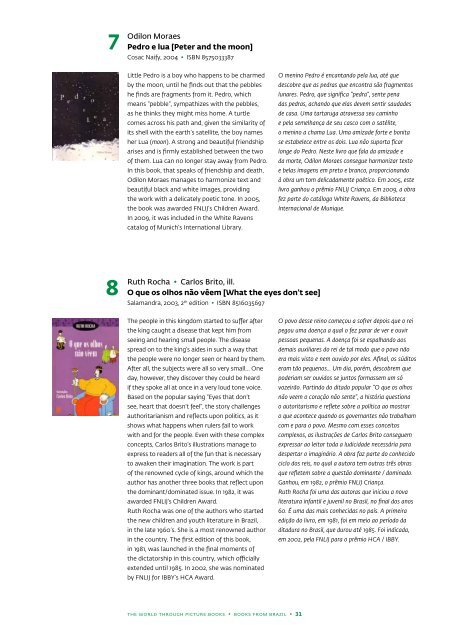world_pictures
world_pictures
world_pictures
You also want an ePaper? Increase the reach of your titles
YUMPU automatically turns print PDFs into web optimized ePapers that Google loves.
7<br />
Odilon Moraes<br />
Pedro e lua [Peter and the moon]<br />
Cosac Naify, 2004 • ISBN 8575033387<br />
Little Pedro is a boy who happens to be charmed<br />
by the moon, until he finds out that the pebbles<br />
he finds are fragments from it. Pedro, which<br />
means “pebble”, sympathizes with the pebbles,<br />
as he thinks they might miss home. A turtle<br />
comes across his path and, given the similarity of<br />
its shell with the earth’s satellite, the boy names<br />
her Lua (moon). A strong and beautiful friendship<br />
arises and is firmly established between the two<br />
of them. Lua can no longer stay away from Pedro.<br />
In this book, that speaks of friendship and death,<br />
Odilon Moraes manages to harmonize text and<br />
beautiful black and white images, providing<br />
the work with a delicately poetic tone. In 2005,<br />
the book was awarded FNLIJ’s Children Award.<br />
In 2009, it was included in the White Ravens<br />
catalog of Munich’s International Library.<br />
O menino Pedro é encantando pela lua, até que<br />
descobre que as pedras que encontra são fragmentos<br />
lunares. Pedro, que significa “pedra”, sente pena<br />
das pedras, achando que elas devem sentir saudades<br />
de casa. Uma tartaruga atravessa seu caminho<br />
e pela semelhança de seu casco com o satélite,<br />
o menino a chama Lua. Uma amizade forte e bonita<br />
se estabelece entre os dois. Lua não suporta ficar<br />
longe do Pedro. Neste livro que fala da amizade e<br />
da morte, Odilon Moraes consegue harmonizar texto<br />
e belas imagens em preto e branco, proporcionando<br />
à obra um tom delicadamente poético. Em 2005, este<br />
livro ganhou o prêmio FNLIJ Criança. Em 2009, a obra<br />
fez parte do catálogo White Ravens, da Biblioteca<br />
Internacional de Munique.<br />
8<br />
Ruth Rocha • Carlos Brito, ill.<br />
O que os olhos não vêem [What the eyes don’t see]<br />
Salamandra, 2003, 2 th edition • ISBN 8516035697<br />
The people in this kingdom started to suffer after<br />
the king caught a disease that kept him from<br />
seeing and hearing small people. The disease<br />
spread on to the king’s aides in such a way that<br />
the people were no longer seen or heard by them.<br />
After all, the subjects were all so very small… One<br />
day, however, they discover they could be heard<br />
if they spoke all at once in a very loud tone voice.<br />
Based on the popular saying “Eyes that don’t<br />
see, heart that doesn’t feel”, the story challenges<br />
authoritarianism and reflects upon politics, as it<br />
shows what happens when rulers fail to work<br />
with and for the people. Even with these complex<br />
concepts, Carlos Brito’s illustrations manage to<br />
express to readers all of the fun that is necessary<br />
to awaken their imagination. The work is part<br />
of the renowned cycle of kings, around which the<br />
author has another three books that reflect upon<br />
the dominant/dominated issue. In 1982, it was<br />
awarded FNLIJ’s Children Award.<br />
Ruth Rocha was one of the authors who started<br />
the new children and youth literature in Brazil,<br />
in the late 1960’s. She is a most renowned author<br />
in the country. The first edition of this book,<br />
in 1981, was launched in the final moments of<br />
the dictatorship in this country, which officially<br />
extended until 1985. In 2002, she was nominated<br />
by FNLIJ for IBBY’s HCA Award.<br />
O povo desse reino começou a sofrer depois que o rei<br />
pegou uma doença a qual o fez parar de ver e ouvir<br />
pessoas pequenas. A doença foi se espalhando aos<br />
demais auxiliares do rei de tal modo que o povo não<br />
era mais visto e nem ouvido por eles. Afinal, os súditos<br />
eram tão pequenos... Um dia, porém, descobrem que<br />
poderiam ser ouvidos se juntos formassem um só<br />
vozeirão. Partindo do ditado popular “O que os olhos<br />
não veem o coração não sente”, a história questiona<br />
o autoritarismo e reflete sobre a política ao mostrar<br />
o que acontece quando os governantes não trabalham<br />
com e para o povo. Mesmo com esses conceitos<br />
complexos, as ilustrações de Carlos Brito conseguem<br />
expressar ao leitor toda a ludicidade necessária para<br />
despertar o imaginário. A obra faz parte do conhecido<br />
ciclo dos reis, no qual a autora tem outras três obras<br />
que refletem sobre a questão dominante / dominado.<br />
Ganhou, em 1982, o prêmio FNLIJ Criança.<br />
Ruth Rocha foi uma das autoras que iniciou a nova<br />
literatura infantil e juvenil no Brasil, no final dos anos<br />
60. É uma das mais conhecidas no país. A primeira<br />
edição do livro, em 1981, foi em meio ao período da<br />
ditadura no Brasil, que durou até 1985. Foi indicada,<br />
em 2002, pela FNLIJ para o prêmio HCA / IBBY.<br />
the <strong>world</strong> through picture books • books from brazil • 31


